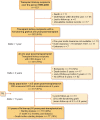Relationship between decline in estimated or measured glomerular filtration rate and 16-year postrenal transplant outcome
- PMID: 34084462
- PMCID: PMC8162849
- DOI: 10.1093/ckj/sfaa203
Relationship between decline in estimated or measured glomerular filtration rate and 16-year postrenal transplant outcome
Abstract
Background: Glomerular filtration rate (GFR) decline ≥30% over 2 years can substitute for the conventional 'doubling of serum creatinine' to predict end-stage renal disease in patients with native kidneys. While chronic kidney disease trajectory is less predictable in transplanted patients, recent data have suggested that similar GFR decline might be an acceptable surrogate for long-term transplant outcome. We sought (i) to confirm the prognostic value of an early GFR decline in kidney transplant recipients and (ii) to determine whether using direct measurement of GFR with inulin improves the performance of this surrogate.
Methods: We retrospectively analysed all recipients transplanted between 1989 and 2000 in our centre, with inulin-measured and Chronic Kidney Disease Epidemiology Collaboration (CKD-EPI)-estimated GFR at 1 and 5 years post-transplant, and evaluated the performance [time-dependent area under the receiver operating characteristic curve (ROC AUC) and subdistribution hazard ratio (sdHR) with competing risk model] of GFR change to predict graft failure and all-cause mortality.
Results: Out of 417 kidney transplant recipients, 116 patients had lost their graft and 77 had died 16 years after transplantation. While being significantly associated with graft failure [sdHR = 2.37 (95% confidence interval 1.47-3.83)], CKD-EPI-GFR decline ≥30% failed to appropriately predict long-term graft survival (C-statistics of 0.63). Concordance between inulin-GFR and CKD-EPI-GFR to detect similar GFR change was only 53%. Inulin-GFR change was, however, not a better predictor (C-statistics of 0.59). Comparable results were observed for mortality.
Conclusions: Our data suggest that early GFR decline is a poor surrogate for long-term transplant outcome, even when change in GFR is directly measured by a reference method.
Keywords: CKD-EPI equation; glomerular filtration rate decline; inulin; kidney transplantation; prognosis.
© The Author(s) 2020. Published by Oxford University Press on behalf of ERA-EDTA.
Figures



References
-
- Stevens LA, Greene T, Levey AS.. Surrogate end points for clinical trials of kidney disease progression. Clin J Am Soc Nephrol 2006; 1: 874–884 - PubMed
-
- Badve SV, Palmer SC, Hawley CM. et al. Glomerular filtration rate decline as a surrogate end point in kidney disease progression trials. Nephrol Dial Transplant 2016; 31: 1425–1436 - PubMed
-
- Srinivas TR, Oppenheimer F.. Identifying endpoints to predict the influence of immunosuppression on long-term kidney graft survival. Clin Transplant 2015; 29: 644–653 - PubMed
-
- Levey AS, Inker LA, Matsushita K. et al. GFR Decline as an end point for clinical trials in CKD: a scientific workshop sponsored by the National Kidney Foundation and the US Food and Drug Administration. Am J Kidney Dis 2014; 64: 821–835 - PubMed
-
- White CA, Siegal D, Akbari A. et al. Use of kidney function end points in kidney transplant trials: a systematic review. Am J Kidney Dis 2010; 56: 1140–1157 - PubMed
LinkOut - more resources
Full Text Sources

